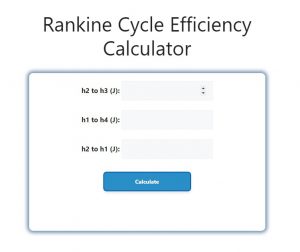About Rankine Cycle Efficiency Calculator (Formula)
The Rankine Cycle Efficiency Calculator is a crucial tool in thermodynamics, particularly in evaluating the performance of steam power plants. This calculator helps determine the efficiency of the Rankine cycle, which converts heat into mechanical work. Understanding this efficiency is essential for optimizing power plant operations and improving energy conservation.
Formula
The formula for calculating Rankine Cycle Efficiency is as follows:
Rankine Cycle Efficiency (Erank) = [(h2 – h3) – (h1 – h4)] / (h2 – h1) * 100
Where:
- h1 = Enthalpy at the boiler inlet
- h2 = Enthalpy at the boiler outlet
- h3 = Enthalpy at the turbine outlet
- h4 = Enthalpy at the condenser inlet
This formula evaluates how effectively energy is converted from heat into work during the Rankine cycle.
How to Use
To use the Rankine Cycle Efficiency Calculator, follow these steps:
- Enter Enthalpy Values: Input the values of enthalpy at different stages: h1 (boiler inlet), h2 (boiler outlet), h3 (turbine outlet), and h4 (condenser inlet).
- Apply the Formula: Use the formula to compute the cycle efficiency.
- Get the Efficiency Result: The calculator will provide the efficiency as a percentage, showing how well the Rankine cycle converts heat into mechanical work.
Example
Let’s assume the following values for enthalpy at different points of the cycle:
- h1 = 1800 kJ/kg
- h2 = 2800 kJ/kg
- h3 = 2000 kJ/kg
- h4 = 1000 kJ/kg
Applying the formula:
Erank = [(2800 – 2000) – (1800 – 1000)] / (2800 – 1800) * 100
Erank = [800 – 800] / 1000 * 100
Erank = 0 / 1000 * 100 = 0%
In this case, the efficiency would be zero, indicating no energy conversion efficiency, but in real-world applications, positive values are expected based on more realistic enthalpy inputs.

FAQs
- What is the Rankine cycle?
The Rankine cycle is a thermodynamic cycle used to convert heat into mechanical work, primarily in steam power plants. - Why is Rankine cycle efficiency important?
It is crucial because it determines how efficiently a power plant converts heat energy into mechanical work, impacting overall energy conservation. - What is enthalpy in the Rankine cycle?
Enthalpy represents the total heat content of a substance, which plays a key role in calculating energy transfers during the cycle. - What units are used for enthalpy in the Rankine cycle?
Enthalpy is typically measured in kilojoules per kilogram (kJ/kg). - What factors affect the efficiency of the Rankine cycle?
The efficiency is affected by boiler pressure, turbine efficiency, condenser performance, and the type of working fluid used. - Can the Rankine Cycle Efficiency Calculator handle superheated steam?
Yes, the calculator can be used with superheated steam if you input the appropriate enthalpy values for the superheated state. - What happens if the enthalpy values are incorrect?
Incorrect enthalpy values will result in inaccurate efficiency calculations. - How can I improve the efficiency of the Rankine cycle?
Efficiency can be improved by increasing boiler pressure, using reheaters, or implementing regenerative feedwater heating. - What is the typical efficiency of a Rankine cycle?
A typical Rankine cycle efficiency for a modern steam power plant ranges between 30-40%. - Is there a difference between Rankine and Carnot cycle efficiencies?
Yes, the Carnot cycle represents the theoretical maximum efficiency, while the Rankine cycle accounts for real-world losses. - Why is condenser efficiency important in the Rankine cycle?
The condenser is crucial for rejecting heat from the cycle. Poor condenser efficiency leads to reduced overall cycle efficiency. - What is the role of the boiler in the Rankine cycle?
The boiler converts water into steam, providing the energy input required for the cycle to produce work. - Can the Rankine cycle operate without a condenser?
No, the condenser is essential for cooling the exhaust steam and maintaining the cycle’s continuous operation. - What is the significance of the turbine in the Rankine cycle?
The turbine converts the thermal energy of steam into mechanical energy, which can then be used to generate electricity. - Can the Rankine Cycle Efficiency Calculator be used for non-steam cycles?
The calculator is primarily designed for steam-based Rankine cycles but can be adapted for other fluids with the right enthalpy values. - How does reheating improve Rankine cycle efficiency?
Reheating increases the average temperature at which heat is added, improving the cycle’s thermal efficiency. - Can regenerative heating improve Rankine cycle efficiency?
Yes, regenerative feedwater heating recycles some of the heat back into the system, increasing efficiency. - Why do power plants use the Rankine cycle?
It’s a well-established, efficient method for converting heat energy into mechanical work, making it ideal for large-scale power generation. - What role does pressure play in the Rankine cycle?
Higher boiler pressure increases the temperature at which heat is added, improving the cycle’s efficiency. - Is there an ideal working fluid for the Rankine cycle?
Steam (water) is the most common working fluid due to its high specific heat capacity and wide availability.
Conclusion
The Rankine Cycle Efficiency Calculator is an essential tool for analyzing the performance of steam power plants. By using this calculator, engineers can optimize power plant operations by identifying inefficiencies and making necessary adjustments. With a solid understanding of the formula and enthalpy values, users can effectively use this tool to improve energy conversion in real-world applications.